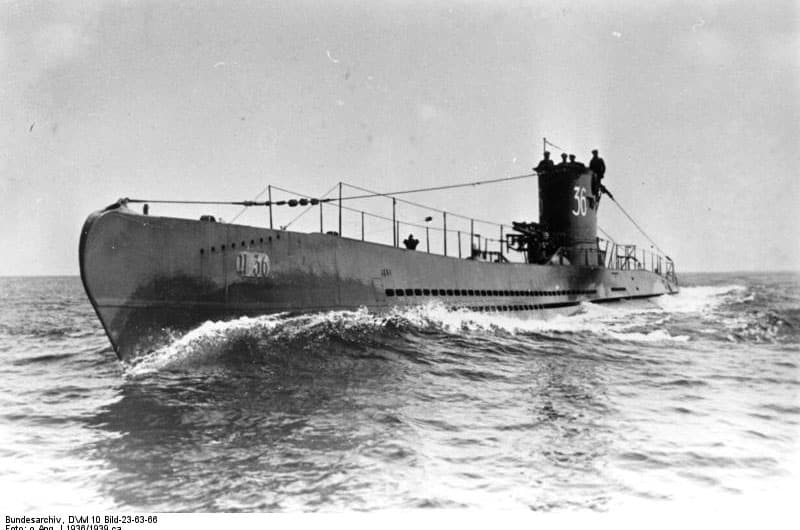• by Amy Jenness, author of On This Day in Nantucket History •
In May of 1942, the German Navy sent 8 submarines to prowl Atlantic waters and destroy ships belonging to their enemies. The grouping, one of the Germans’ famous “wolf packs,” was called Pfadfinder and the impact of that mission brought World War II far too close to Nantucket for comfort.
On May 17, the British merchant ship SS Peisander was traveling 350 miles southeast of Nantucket when the German U-653 torpedoed it. Sinking and stranded in a dense fog on Nantucket Shoals, the SS Peisander called the US Coast Guard for assistance. When the crew of the cutter General Greene arrived they first saw a lifeboat with the survivors and then noticed a U Boat crash diving in front of their bow. The cutter tried to ram the submarine, but it slipped beneath the surface. After tracking the Germans with sonar, the General Greene dropped three depth charges, which produced a 400 foot oil slick. The cutter lost contact at that point and returned to rescue the 18 survivors, who were brought to Newport, RI.
While it may have been damaged, the U-653, which would be at sea a total of 73 days, was still operable and continued south with the wolf pack. The U-653 would continue to sink enemy ships for the Germans until a British carrier destroyed it in March of 1944.
On May 25, the Dutch merchant vessel Polyphemus discovered a life boat drifting north of Bermuda and rescued 14 men who had been driven from their ship Norland, a Norweigian tanker with a cargo of ballast, five days earlier when the sole German U-108, which was not part of a wolf pack, torpedoed and sank it. Two days later all but 15 people onboard the Polyphemus would escape to that vessel’s life boats when the German submarine U-578, traveling in the wolf pack Pfadfinder, sank their ship.
The U-578 had been stalking the unescorted Polyphemus for five hours before firing three torpedoes into her. The explosions ruined the stern and killed 15 Chinese crew members in their quarters. The remaining crew, passengers and the rescued Norland survivors abandoned ship in five lifeboats and the 6,000 ton ship, with its cargo of wool and wheat, sank within an hour.
Shortly after the survivors got into their lifeboats the U-boat surfaced and the Germans questioned the captain about his torpedoed vessel. The Germans gave the survivors a carton of cigarettes and directions to New York City and left .
The five open boats tried to remain together but on the second night they separated. On May 29 an unknown U-boat surfaced by one of the boats early in the morning and asked why they were adrift at sea, wished them a good trip and departed. Soon after the 15 men were picked up by a Portuguese steamer named Maria Amelia. A German submarine had also been stalking the Maria Amelia that day, but stopped when it saw her neutrality markings. The Portuguese crew delivered the 15 survivors to New York City on June 1.
Also on June 1, 10 men on another life boat were picked up by an American fishing boat 50 miles northeast of the Nantucket Lightship and taken to New Bedford. Twelve men from the third life boat were picked up about 130 miles east of Nantucket on June 2, transferred to an American fishing boat and taken to New Bedford on June 3. Seventeen men from the fourth life boat were rescued by a Portuguese ship on June 3 and taken to New York City on June 5.
The final life boat containing 10 men also encountered a U Boat while drifting at sea. On May 29 the boat surfaced to speak with them. The Germans gave the survivors water and directions to the nearest land and left. The next day the same U Boat surfaced again and gave the crew bread and a bottle of rum. Five days later the survivors were finally picked up by US Coast Guard cutter General Greene on June 5 and brought to Nantucket.
The U-578, captained by Ernst-August Rehwinkel, who at age 41 was one World War II’s oldest U-boat commanders, struck again on June 2 when his submarine sank the Norwegian merchant ship Berganger southeast of Cape Cod. Once again the Germans surfaced, questioned the survivors, took their pictures and departed. The 47 survivors were rescued and brought to land on June 4. Two months later, U-Boat captain Rehwinkel, his crew and the U 578 were all inexplicably lost on August 6 in the Bay of Biscay.
All this maritime destruction so close to the island put Nantucketers on edge and soon rumors circulated claiming that the US government would take control of the island and that the US Navy would seize all the steamships serving the island. Afraid that the rumors would scare away summer visitors, Nantucket selectmen put advertisements in the Inquirer & Mirror that sternly admonished those who had spread them and reassured readers that Nantucket would be a safe. On June 14, The New York Times ran an article announcing Nantucket summer steamship service and urging people to vacation on “charming Nantucket,” a news item that may have been instigated by the Nantucket Public Relations Committee which was tasked by selectmen to address the issue.



